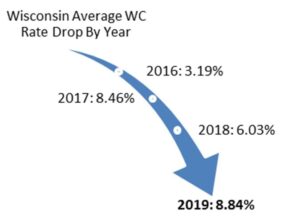How to protect your business from earthquakes

3 minute read
Every year, there are approximately 5000 minor and major earthquakes recorded in Canada. These natural events are unpredictable and can occur in any season. Earthquakes violently shake the ground due to tectonic plates shifting along a fault line beneath the earth’s crust. They can vary in duration, magnitude, and density. While minor earthquakes may only last for just a few seconds and pose little to no danger, major earthquakes can last several minutes and cause severe destruction including structural damage and extensive utility disruptions.
In Canada, British Columbia experiences the most major earthquakes as it’s located along the Pacific Ocean, where some of the most active faults in the world are. However, contrary to popular belief, Ontario and Québec frequently have earthquakes along the St. Lawrence and Ottawa River valleys.
Given their unpredictable nature, it’s essential as a small business owner to take the time to prepare your business for an earthquake. Here’s what you can do before, during and after an earthquake.
How to prepare your business before an earthquake
Adopting a proactive stance can help mitigate the potential impact of an earthquake on your business. Here are some essential measures to take before a disaster strikes:
Develop a business continuity and disaster plan
Ensure all employees are trained on what to do in the event of an earthquake. They should know where and how to continue working, if possible, in a safe alternate location or from home. Employees must understand how to shut off utilities such as water, electricity, and gas. You should have clear “on” and “off” labels for each one.
Gather and maintain emergency kits
Your emergency kits should be easily accessible and include the following items:
Emergency contact list
First-aid kit
Battery-powered flashlight
Generators, backup batteries and power banks
Candle and matches
Water bottles
Non-perishable food, such as canned foods and energy bars
Manual can opener
Portable weather radio
Protect your property
To help minimize potential damage to your property, here are some steps you can take:
Consult a structural or seismic engineer about seismic retrofits for your building. You may also want to install seismic gas shut-off valves to reduce the chances of a fire or explosion after an earthquake.
Regularly inspect and repair any loose or damaged building components.
Remove trees and branches that can fall on your roof or nearby power lines.
Secure building fixtures, such as gas-fired equipment and water heaters, to masonry or wall studs using seismic strapping.
Use anchors and fasteners to secure loose objects, such as furniture, appliances, and electronics, to the wall or floor.
Install safety latches on drawers and cupboards to stop contents from falling out and store heavy items on lower shelves or the ground.
What to do during an earthquake
During an earthquake, stay indoors and drop, cover and hold on. Drop under heavy and solid furniture, such as a desk or table. Cover your head and torso from being hit by moving items. Hold on to the structure you are under so that you stay covered until the shaking ends.
If you are unable to go underneath a strong structure, or you are in a hallway, crouch or flatten against an interior wall while protecting your head and neck. Avoid standing near exterior walls, windows, doorways, shelves with heavy objects, light fixtures and items hung on walls. Never use an elevator during an earthquake! If you are already in one when the earthquake starts, exit as soon as you can.
If you are outdoors, find an open area away from buildings that could collapse. Remember to maintain a safe distance of at least 10 meters from downed power lines. For those near coastlines, move inland or toward higher ground. If you are in a crowded area, keep moving until you find a safe space to take cover to avoid being trampled by panicked crowds.
How to recover after an earthquake
After an earthquake, be aware of aftershocks, which are smaller earthquakes following a larger one. Make sure to assess your surroundings and get ready to move if there are unstable structures or objects can still fall or hit you. Help others who need assistance and if you cannot reach them safely, contact emergency services or if you don’t have access to a phone, place a “HELP” sign against a window.
Access your emergency kits for essential supplies and look out for mobile alerts or listen on a weather radio for instructions from authorities. Keep your utilities turned off and unplug all electronics and lights to prevent a fire from igniting. If you smell leaking gas or see hazardous material spills or flooding, evacuate immediately.
Lastly, take photos and document any structural damages to your buildings and vehicles, as this may help with investigations or claims needed.
Ensure your business is protected with TruShield
Earthquakes are unpredictable natural events that can cause tremendous property damage, business interruption and personal injury. By taking the appropriate measuresbefore, during and after an earthquake, you can reduce the severity of these effects. However, sometimes things can still go wrong. Having the right protection in place can make all the difference to you and your business. To learn more about how the right coverage can help, visit our Business Insurance page today.
This blog is provided for information only and is not a substitute for professional advice. We make no representations or warranties regarding the accuracy or completeness of the information and will not be responsible for any loss arising out of reliance on the information.





